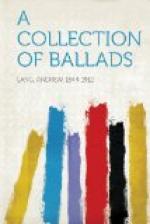Lord Airly’s houses were destroyed by Argyll, representing the Covenanters, and also in pursuance of a private feud, in 1639, or 1640. There are erroneous versions of this ballad, in which Lochiel appears, and the date is, apparently, transferred to 1745. Montrose, in his early Covenanting days, was not actually concerned in the burning of the Bonnie House, which he, when a Royalist, revenged on the possessions of “gleyed Argyll.” The reference to “Charlie” is out of keeping; no one, perhaps, ever called Charles I. by that affectionate name. Lady Ogilvie had not the large family attributed to her: her son, Lord Ogilvie, escaped from prison in the Castle of St. Andrews, after Philiphaugh. A Lord Ogilvie was out in 1745; and, later, had a regiment in the French Service. Few families have a record so consistently loyal.
ROB ROY
The abductors of the widowed young heiress of Edenhelly were Rob’s sons, Robin Oig, who went through a form of marriage with the girl, and James Mohr, a good soldier, but a double-dyed spy and scoundrel. Robin Oig was hanged in 1753. James Mohr, a detected traitor to Prince Charles, died miserably in Paris, in 1754. Readers of Mr. Stevenson’s Catriona know James well; information as to his villanies is extant in Additional MSS. (British Museum). This is probably the latest ballad in the collection. It occurs in several variants, some of which, copied out by Burns, derive thence a certain accidental interest. In Mr. Stevenson’s Catriona, the heroine of that name takes a thoroughly Highland view of the abduction. Robin Oig, in any case, was “nane the waur o’ a hanging,” for he shot a Maclaren at the plough-tail, before the Forty-Five. The trial of these sons of Alpen was published shortly after Scott’s Rob Roy.
KILLIECRANKIE
Fought on July 27, 1689. Not on the haugh near the modern road by the railway, but higher up the hill, in the grounds of Urrard House. Two shelter trenches, whence Dundee’s men charged, are still visible, high on the hillside above Urrand. There is said, by Mr. Child, to have been a contemporary broadside of the ballad, which is an example of the evolution of popular ballads from the old traditional model. There is another song, by, or attributed to, Burns, and of remarkable spirit and vigour.
ANNAN WATER
From The Border Minstrelsy Scott says that these are the original words of the tune of “Allan Water,” and that he has added two verses from a variant with a fortunate conclusion. “Allan Water” is a common river name; the stream so called joins Teviot above Branxholme. Annan is the large stream that flows into the Solway Frith. The Gate-slack, in Annandale, fixes the locality.




